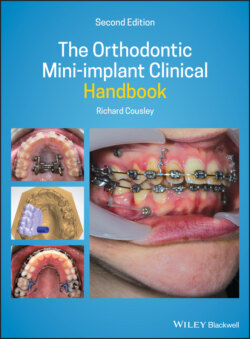Читать книгу The Orthodontic Mini-implant Clinical Handbook - Richard Cousley - Страница 28
1.15 Soft Tissue Problems
ОглавлениеThe most common soft tissue issue related to mini‐implant usage is chronic low‐grade peri‐implant inflammation. This is analogous to gingivitis around the mini‐implant neck, and is usually superficial and self‐limiting. It is more likely if the mini‐implant is either inserted into an area of mobile mucosa (Figure 1.6) or overinserted (partially submerged) in attached gingiva (Figure 1.7). If tissue hyperplasia fails to resolve with oral hygiene measures, and either interferes with use of the mini‐implant or causes patient discomfort, then the mini‐implant should be removed. Fortunately, acute infections are rarely seen. For example, an audit of my first 500 mini‐implant insertions confirmed that only one patient had returned to clinic within several days with a painful, inflamed soft tissue swelling around a mini‐implant. This episode of acute infection was readily resolved by immediate explantation of the mini‐implant, without the need for antibiotics.
It is also unlikely that peri‐implant colonisation by specific pathogenic bacteria is responsible for infection problems in failed mini‐implants, as demonstrated by microbiological studies (comparing successful and failed mini‐implant flora) [62–65]. Instead, soft tissue causes of failure are probably related to generalised inflammation effects. Even then, it is likely that the soft tissue influences on stability are small compared with other factors such as root proximity.
The labial or buccal mucosa adjacent to a mini‐implant head may occasionally be traumatised, manifesting as a mucosal ulcer (Figure 1.8). This is most likely to occur if the mini‐implant has a prominent profile (a long head and neck distance from the tissue surface) or sharp edges, or it is inserted in or near loose mucosa. Conversely, mucosal hyperplasia or ulceration may occur if the traction auxiliary (in direct anchorage scenarios) impinges excessively on the underlying mucosa, especially in the presence of poor oral hygiene (Figure 1.9).
